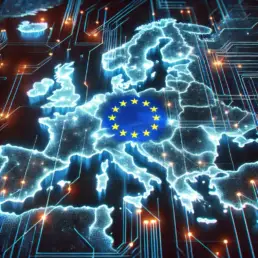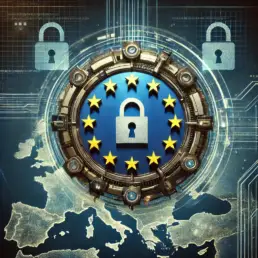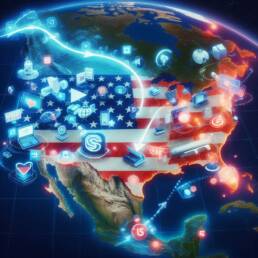From Penguin OS to Continental Control: Charting a Course to Digital Independence

Introduction: The European Quest for Digital Independence
What began as a search for “video editing platforms for Linux”. A noble quest, one might think, to escape the clutches of proprietary operating systems. It qickly spiralled, into a rabbit hole of US tech dominance. Even Skype, that once plucky European upstart, was long ago assimilated into the Borg-like collective of Microsoft. It seems that every digital avenue, every promising piece of software, every online service, ultimately leads back to the sprawling campuses of Silicon Valley. For video editors, this often means a reliance on expensive subscriptions and ecosystems that might not always align with their needs or values.
A recent survey by the European Video Editors Association in 2024 indicates that 85% of European video editors rely on US-based software, highlighting the extent of this dependence. This reliance not only raises concerns about data privacy and security but also stifles the growth of the European tech sector and limits the control European creators have over their digital tools. This article explores how European video editors and other creative professionals can achieve digital independence by embracing European and open-source alternatives, with a particular focus on Linux-based solutions. We will examine the geopolitical and cultural reasons for this shift, provide practical steps for transitioning to EU tech, and address the challenges and opportunities that lie ahead.
Many are seeking EU digital sovereignty alternatives to US tech dominance and exploring how to achieve EU technological independence from the US, and this article aims to provide a practical guide for video editors and other creative professionals.
Why EU Tech Matters: A Matter of Sovereignty and Soul
This isn’t just a minor inconvenience, like discovering your favourite tea biscuits are out of stock. With the geopolitical landscape resembling a particularly wobbly bank manager, and NATO’s stability feeling shakier than a tangerine’s handshake, the establishment of genuine EU tech sovereignty has moved beyond mere trendiness. It is, quite frankly, a matter of survival.

Geopolitical Imperative: Safeguarding Data and Democracy
If Silicon Valley, with its insatiable appetite for data, hoards information like Smaug guarding his gold – albeit with spreadsheets instead of a fiery breath – then EU tech tools must be our Gandalf: wise, protective, and crucially, GDPR-certified. The sheer volume of data amassed by US tech giants grants them considerable economic and political leverage, which can potentially undermine the autonomy of nations. This concentration of digital power is a risk the EU can ill afford to ignore, particularly in an increasingly volatile world. European alternatives, built with a foundational respect for privacy enshrined in regulations like GDPR, offer a counter-narrative. They represent a commitment to democratic values and the safeguarding of citizens’ digital rights, a stark contrast to the often opaque and data-hungry practices of their US counterparts. The EU’s regulatory approach positions it as a global leader in promoting a human-rights-oriented model for technology governance .
For example, the Snowden revelations in 2013 exposed the extent of US surveillance programs, raising concerns about the privacy of European citizens’ data stored on US servers. More recently, there have been concerns about data transfers between the EU and the US, and the legal basis for these transfers, highlighting the ongoing need for stronger EU data protection measures. These instances underscore why the EU needs its own digital infrastructure and the importance of comparing EU and US approaches to data privacy to fully appreciate the shift towards European tech. The current geopolitical landscape, with increasing tensions and a rise in cyber warfare, further emphasizes the need for the EU to control its digital infrastructure and protect its data from potential threats. While US tech companies have undoubtedly driven innovation and provided valuable services, the EU’s reliance on them creates a potential vulnerability that could be exploited.
Cultural Resonance: Nurturing European Innovation
Choosing EU tech is akin to swapping a slice of processed Kraft Singles for a generous wedge of proper Swiss raclette – less plastic, infinitely more soul. It’s about more than just functionality; it’s about nurturing European innovation, supporting our own businesses, and fostering a digital environment that reflects our diverse cultures and values. Just as we champion our rich artistic and culinary heritage, so too should we take pride in our technological advancements. Opting for European tech is a tangible act of cultural pride, bolstering the growth of our own digital ecosystem.
Some might argue that US tech offers greater convenience or a wider range of features.
However, overcoming these ingrained preferences requires a conscious and collective effort to actively support European alternatives. By choosing European tech, we invest in our own future, fostering a digital landscape that reflects our values and priorities. This is about more than just data protection; it’s about fostering a digital environment that is aligned with European cultural and societal norms. Supporting EU tech companies for digital sovereignty is not just a matter of economic strategy, but also a way to ensure that the role of open-source in EU digital sovereignty remains strong and how individuals can support EU digital sovereignty is clear and actionable.
Next, we’ll look at the everyday apps you can migrate to, moving away from US-based services.
A hint of them is below.
Or, skip ahead to the video/photo apps that are free from US influence.
EU Tech Alternatives to US Tech Giants
Embrace Digital Sovereignty with European Solutions
Communication & Social
Mastodon
Decentralized social networking platform similar to Twitter but with better privacy controls
joinmastodon.orgPeerTube
Decentralized video platform that provides an alternative to YouTube
joinpeertube.orgElement
Secure messenger based on the Matrix protocol, alternative to WhatsApp/Slack
element.ioProductivity & Storage
Nextcloud
Self-hosted cloud storage and collaboration platform, alternative to Google Drive
nextcloud.comDeepL
High-quality AI translation tool, alternative to Google Translate
deepl.comBrowsing & Searching
Smart Home
Home Assistant
Open-source smart home platform with focus on privacy
Visit Website →Creative Tools
DaVinci Resolve
Professional video editing & color grading software
Visit Website →Joe Savitch-Lee
Over 20 years in media, having worked on four continents and on countless projects both on location and in a suite. He has excelled in both building/maintaining editing systems and editing them.
Related Posts
April 4, 2025
TikTok’s Uncertain Future: Acquisition Bids and Emerging Video Platform Alternatives
With TikTok facing global scrutiny, creators need to be ready. This guide…
March 28, 2025
De-Americanize Your Digital Life: A Practical Guide to Switching to EU Tech
Tired of being locked into US tech? This article explores how European video…





